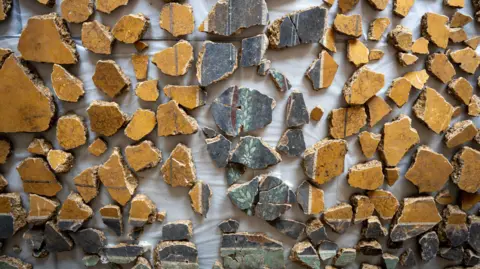In a remarkable archaeological discovery, researchers have meticulously reconstructed thousands of fragments of wall plaster from a Roman villa that date back 2,000 years. This extraordinary jigsaw puzzle, unearthed from a redevelopment site in Central London, showcases stunning frescoes that offer a glimpse into the opulence of a bygone era. The recovered artwork reflects intricately painted imagery of musical instruments, flora, and fauna, revealing insights into the lifestyles and culture of the elite Roman inhabitants of London at that time.
The fragments of plaster were initially discovered in 2021, but the intricate task of reconstruction required substantial time and effort. The fresh insights gleaned from these murals are shedding light on what has been described as the “Beverly Hills of Roman London,” a locale reflecting affluence and status in ancient England. Experts from the Museum of London Archaeology, known as Mola, are excited about the implications of these frescoes for understanding the social dynamics of Roman Britain.
Among the remarkable aspects of this discovery is the sheer volume of art recovered, which includes representations from at least 20 walls of the villa. The vivid frescoes included depictions of life in ancient times, such as birds, grapes, flowers, and various musical instruments, effectively painting a picture of luxury and refinement that graced the homes of wealthy Romans. Not only do these images evoke the lifestyle of a wealthy family or possibly a hotel serving affluent travelers of that era, but they also indicate the time period in which the villa flourished, likely during the first or second century, a period of rapid growth in Londinium.
Intriguingly, the reconstruction process has revealed hints about the artisans behind this artistry. One particular fragment contains the Latin term “Fecit,” translating to “has made this,” but unfortunately, the crucial piece that would reveal the artist’s name is still missing, adding an air of mystery to the find. The team at Mola remains hopeful about uncovering this vital fragment as they sift through additional pieces. Han Li, an archaeologist from Mola, emphasizes the significance of this discovery by noting that it may represent the largest collection of Roman wall art and plaster found to date in Rome’s British territories.
The artistic style and subject matter of these frescoes indicate a possible blend of Classical Roman techniques with local influences. For example, the vibrant imagery includes not only traditional Roman motifs but also elements indicative of the northern European environment. Researchers point to the depiction of mistletoe, a plant native to the area, as evidence of this cultural intertwining. This unique artistic interpretation provides a fascinating narrative about the adaptability of Roman artistry across different regions of their expansive empire.
The complexity and fragility of the mosaic pieces posed unique challenges for the archaeologists. Han Li recounted the laborious process of assembling the fragments, likening it to “the world’s most difficult jigsaw puzzle.” The ancient plaster is delicate, necessitating careful handling to avoid further deterioration. Each piece had to be scrutinized for signs of connection, adding layers of complexity to their reconstruction efforts.
As excavations continued in Southwark, further discoveries, including a beautiful mosaic and a Roman cemetery, highlighted the area’s historical significance and its bustling early settlement status. The expanding borders of Roman London have further implications for understanding how the city evolved over time and what it meant to invest in the area.
In summary, the rediscovery of these Roman frescoes in London allows us to peer into the wealth and sophistication of its ancient society. As archaeologists like Han Li continue to work diligently to trace their history, they simultaneously illustrate the broader narratives of cultural exchange and adaptation in Roman Britain. Until the missing pieces are found, the full story behind these artworks remains tantalizingly incomplete, underscoring the continued relevance of archaeological work in uncovering human history.



